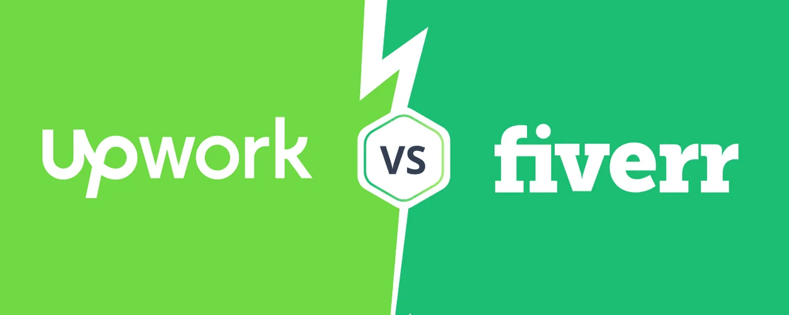Fiverr vs Upwork: Why Fiverr is the Better Choice for Outsourcing
2/14/20258 min read


Introduction to Fiverr and Upwork
In the ever-evolving landscape of freelancing, Fiverr and Upwork have emerged as two of the most prominent platforms connecting freelancers with clients. Established in 2010, Fiverr has gained a reputation for its gig-based model, allowing freelancers to offer specific services at set prices, starting from as low as $5. This model has attracted a diverse range of talents, from graphic designers to writers, making it a popular choice for clients seeking quick and cost-effective solutions. The platform's straightforward approach encourages freelancers to showcase their skills creatively, appealing to a wide audience and fostering an accessible marketplace for services.
Conversely, Upwork, founded in 2015 through a merger of Elance and oDesk, operates on a more traditional bidding system. Freelancers can submit proposals for projects that clients post, competing based on expertise, experience, and rates. This model allows for a broader range of services, including long-term projects and hourly contracts. Upwork emphasizes quality and professionalism, catering predominantly to businesses seeking skilled professionals for various jobs, from software development to legal consulting.
The perception of each platform among its user base further highlights their distinctions. Fiverr is often associated with smaller, more transactional jobs, while Upwork is seen as suitable for larger and more intricate projects. Clients on Fiverr may prioritize cost-efficiency, whereas Upwork clients often focus on obtaining high-quality work, generally willing to invest more for specialized skills. Such differences in operation and user experience underline why a comprehensive comparison of Fiverr and Upwork is necessary, particularly for clients and freelancers evaluating their options for outsourcing.
Understanding Fiverr and Fiverr Pro
Fiverr is an online marketplace that connects freelancers with clients looking for various services across multiple fields, including graphic design, writing, video editing, and programming. Launched in 2010, Fiverr was designed to provide a platform where freelancers can offer their skills starting at just $5. This unique pricing structure allows clients to explore an array of services based on budget constraints, making it an attractive option for businesses of all sizes. The platform emphasizes transparency, enabling clients to clearly understand what they are purchasing, thanks to standardized service packages offered by freelancers.
One of the standout features of Fiverr is its project-based pricing model, allowing users to define the scope of their projects and budget accordingly. Clients can choose from a variety of packages with clearly defined deliverables, which simplifies the decision-making process. This model provides clarity for both freelancers and clients, minimizing potential misunderstandings regarding project expectations and costs. Additionally, each service listing (known as a "gig") includes customer reviews and ratings, fostering a sense of trust and reliability between parties.
Fiverr Pro is an upgraded tier designed for clients seeking high-quality, professional services. This section of the platform features a curated selection of top-tier freelancers who have undergone a stringent vetting process. By ensuring that only the best talents are represented, Fiverr Pro offers businesses access to premium services that match their high standards. Availability of specialized services, dedicated account management, and the potential for expedited customer support are some of the significant advantages Fiverr Pro provides to its users. With this enhanced level of service, businesses can feel confident in selecting qualified professionals for their projects, ensuring that they receive exceptional value.
Comparing Fiverr and Upwork's Payment Structures
When it comes to outsourcing work, understanding the payment structures of different platforms is crucial for both freelancers and clients. Fiverr operates on an upfront pricing model, where service providers set fixed prices for their offerings. This model promotes budget clarity, allowing clients to know the total cost before committing to a project. By browsing through various service categories, clients can easily compare prices, leading to informed decisions without the concern of hidden fees. This structure can be particularly beneficial for those with strict budgets or for businesses that prefer predictable costs.
In contrast, Upwork employs a more flexible payment system that includes hourly rates and milestone payments. This means that freelancers often charge based on the number of hours worked or by reaching specific project milestones. While this can offer some flexibility for complex projects, it can also result in unexpected costs for clients. Clients may find themselves facing higher-than-anticipated expenses if a project takes longer than estimated. This uncertainty in budgeting can deter potential clients from fully engaging, especially those who are not accustomed to the unpredictability that such hourly arrangements may entail.
Furthermore, both platforms have their own fee structures, impacting the net earnings of freelancers and overall costs. On Fiverr, the platform takes a 20% commission on all transactions, which is clearly stated upfront, allowing freelancers to factor this into their pricing. Conversely, Upwork’s fees vary depending on the contract total, with a sliding scale that can range from 5% to 20%. This variability may complicate cost calculations for freelancers seeking to maximize their earnings. Understanding these differences in payment structures can significantly affect decision-making for both freelancers and clients, ultimately influencing their choice of platform for outsourcing needs.
Quality of Freelancers and Specialists on Fiverr vs Upwork
When comparing the quality of freelancers on Fiverr and Upwork, it is essential to recognize the distinct mechanisms that each platform employs to attract and retain skilled specialists. Fiverr, known for its gig-based model, allows users to browse through a wide array of specific skills, which facilitates an easier identification of relevant expertise tailored to individual project requirements. Freelancers on Fiverr showcase their services via creatively designed gig pages, complete with descriptions, portfolios, and competitive pricing, which offer clients a transparent view of what to expect.
One of the prominent advantages of using Fiverr is the clear rating and review system for each freelancer. Clients can assess the quality of a contractor's work by examining reviews left by previous customers. This level of transparency fosters trust between the freelancer and potential clients, as high ratings and positive feedback serve as credible indicators of skill and professionalism. By allowing users to access these metrics, Fiverr mitigates common concerns regarding the quality and reliability of freelance services.
In contrast, Upwork operates on a bidding system that can sometimes result in a less streamlined selection process. While Upwork has a vast talent pool, the requirement for freelancers to bid on projects can lead to overwhelming choices for clients, making it more difficult to determine the best fit for their needs. Furthermore, the quality of freelancers may vary more significantly on Upwork, as the bidding process can attract varying levels of expertise. As such, verifying a freelancer's qualifications and work history can be a more laborious task on Upwork.
Ultimately, Fiverr's structured environment and emphasis on displaying freelancer capabilities contribute greatly to the overall quality perception among clients. This is particularly noteworthy for those seeking specific skills, as the platform's model encourages professionals to deliver high-quality work to maintain positive reviews and secure future opportunities.
The User Experience: Navigating Fiverr vs Upwork
When considering outsourcing platforms, the user experience is a critical factor that impacts a user's decision-making process. Both Fiverr and Upwork have distinctive interfaces designed to cater to freelancers and clients. However, Fiverr's design prioritizes user-friendliness and a seamless workflow, which can significantly enhance the overall outsourcing experience.
Fiverr employs an intuitive layout that makes navigating their platform straightforward. Users can easily access various categories of services, from graphic design to digital marketing, with just a few clicks. This ease of navigation allows clients to quickly locate appropriate freelancers for their projects. In contrast, Upwork's interface can feel somewhat cluttered and overwhelming. While it offers a wide range of projects and freelancers, the sheer volume of information can complicate the process of finding the right match.
The search functionality on Fiverr is tailored to streamline the selection process. Clients can filter their searches by parameters such as budget, delivery time, and specific skills. This targeted approach not only saves time but also makes it simpler to find freelancers who meet project specifications. In comparison, Upwork offers search filters, but the execution is less efficient, often making it more challenging for users to refine their options quickly.
Moreover, Fiverr's order process is straightforward, guiding users from project selection to payment. The platform allows clients to view freelancer ratings and reviews, providing additional insights that aid decision-making. Upwork, while offering a similar review system, often involves a more complex proposal process that may deter some users. Overall, the flow from discovering a freelancer to completing a project is more cohesive on Fiverr, reinforcing the platform's reputation for enhancing the outsourcing experience.
Flexibility and Service Range on Fiverr vs Upwork
When assessing the flexibility and service range of Fiverr compared to Upwork, it is essential to recognize how each platform approaches the diversity of services. Fiverr is well-regarded for its extensive array of categories that cater to niche requirements, enabling clients to find specialized services quickly and efficiently. The platform divides its offerings into various gig categories, ranging from graphic design and writing to digital marketing and programming. This structured categorization not only simplifies the search process but also promotes a tailored service experience that many clients find appealing.
In contrast, Upwork operates on a broader focus, allowing clients to post job listings for a wide range of services. While this model supports a diverse set of skill sets, it often leads to a more generalized approach to outsourcing. The broader focus can sometimes result in clients having to sift through an overwhelming quantity of applicants, making it challenging to find the most suitable freelancer for highly specialized tasks. Furthermore, Upwork tends to emphasize longer-term projects and ongoing collaborations rather than the shorter, more project-specific gigs that Fiverr promotes.
The flexibility offered by Fiverr’s platform allows freelancers to create packages that can be easily customized to meet the specific needs of clients. This aspect not only enhances the user experience but also gives service providers the opportunity to showcase their unique skills. Additionally, Fiverr's focus on quick turnaround times aligns well with the needs of clients looking for immediate solutions to particular challenges. Overall, the flexibility and diversity of services available on Fiverr makes it an attractive option for clients seeking specialized skills in a rapidly changing marketplace.
Final Thoughts: Why Choose Fiverr Over Upwork
In the dynamic world of freelancing, making the right choice between various platforms can profoundly impact the success of your outsourcing endeavors. As highlighted throughout this discussion, Fiverr presents a myriad of advantages that elevate it above its counterpart, Upwork. Specifically, the introduction of Fiverr Pro positions the platform as a beacon of professionalism, attracting only the most skilled and experienced freelancers. This ensures that businesses can engage with specialists who not only possess the necessary expertise but also have been vetted for quality.
The competitive pricing structure available on Fiverr is another compelling reason to choose this platform. Unlike Upwork, where prices can fluctuate and often escalate due to bidding wars, Fiverr allows users to find services at fixed rates. This transparency in pricing helps businesses manage their budgets effectively, ensuring they receive value for their investment. As startups and established enterprises alike seek cost-effective solutions, Fiverr's approach appeals to a broad audience, providing access to a wealth of talents without the unpredictability associated with hourly billing.
Moreover, the trustworthy specialists that populate Fiverr's marketplace enhance its appeal. Many freelancers on Fiverr maintain high ratings and reviews from previous clients, establishing a credibility that fosters trust. This environment not only enhances the quality of work delivered but also offers peace of mind to those outsourcing tasks for the first time. As more businesses navigate the freelance landscape, having a reliable resource like Fiverr becomes increasingly vital.
In conclusion, when evaluating the benefits of Fiverr versus Upwork, the choice is clear. With its focus on professionalism, competitive pricing, and a reputable pool of specialists, Fiverr stands out as the preferred platform for outsourcing projects. As you consider your next endeavor, it may be beneficial to explore the offerings on Fiverr, ensuring a productive and successful collaboration.






